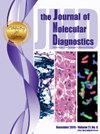Detection of Gene Fusions and Rearrangements in Formalin-Fixed, Paraffin-Embedded Solid Tumor Specimens Using High-Throughput Chromosome Conformation Capture
IF 3.4
3区 医学
Q1 PATHOLOGY
引用次数: 0
Abstract
Chromosomal structural variants (SVs) are major contributors to cancer development. Although multiple methods exist for detecting SVs, they are limited in throughput, such as fluorescent in situ hybridization and targeted panels, and use RNA, which degrades in formalin-fixed, paraffin-embedded (FFPE) blocks and is unable to detect SVs that do not produce a fusion transcript. High-throughput chromosome conformation capture (Hi-C) is a DNA-based next-generation sequencing (NGS) method that preserves the spatial conformation of the genome, capturing long-range genetic interactions and SVs. Herein, a retrospective study analyzing 71 FFPE specimens from 10 different solid tumors was performed. Results showed high concordance (98%) with clinical fluorescent in situ hybridization and RNA NGS in detecting known SVs. Furthermore, Hi-C provided insight into the mechanism of SV formation, including chromothripsis and extrachromosomal DNA, and detected rearrangements between genes and regulatory regions, all of which are undetectable by RNA NGS. Lastly, SVs were detected in 71% of cases in which previous clinical methods failed to identify a driver. Of these, 14% were clinically actionable based on current medical guidelines, and an additional 14% were not in medical guidelines but involve targetable biomarkers. Current data suggest that Hi-C is a robust and accurate method for genome-wide SV analyses from FFPE tissue and can be incorporated into current clinical NGS workflows.
使用 Hi-C 检测 FFPE 实体瘤标本中的基因融合和重排。
染色体结构变异(SV)是癌症发展的主要因素。虽然存在多种检测SVs的方法,但它们的吞吐量有限,例如FISH和靶向面板,使用RNA,其在福尔马林固定石蜡包埋(FFPE)块中降解,并且无法检测不产生融合转录物的SVs。Hi-C是一种基于dna的NGS方法,它保留了基因组的空间构象,捕获了远程遗传相互作用和sv。我们进行了回顾性研究,分析了来自10个不同实体瘤的71例FFPE标本。在检测已知SVs时,我们与临床FISH和RNA NGS显示了高度的一致性(98%)。此外,Hi-C还揭示了SV形成的机制,包括染色体裂解和染色体外DNA,并检测到基因和调控区域之间的重排,这些都是RNA NGS无法检测到的。最后,我们在71%以前的临床方法无法识别驱动因素的病例中检测到SVs,其中14%的病例根据当前的医疗指南在临床上是可操作的,另外14%的病例不在医疗指南中,但涉及可靶向的生物标志物。我们的数据表明,Hi-C是一种可靠且准确的FFPE组织全基因组SV分析方法,可以纳入当前的临床NGS工作流程。
本文章由计算机程序翻译,如有差异,请以英文原文为准。
求助全文
约1分钟内获得全文
求助全文
来源期刊
CiteScore
8.10
自引率
2.40%
发文量
143
审稿时长
43 days
期刊介绍:
The Journal of Molecular Diagnostics, the official publication of the Association for Molecular Pathology (AMP), co-owned by the American Society for Investigative Pathology (ASIP), seeks to publish high quality original papers on scientific advances in the translation and validation of molecular discoveries in medicine into the clinical diagnostic setting, and the description and application of technological advances in the field of molecular diagnostic medicine. The editors welcome for review articles that contain: novel discoveries or clinicopathologic correlations including studies in oncology, infectious diseases, inherited diseases, predisposition to disease, clinical informatics, or the description of polymorphisms linked to disease states or normal variations; the application of diagnostic methodologies in clinical trials; or the development of new or improved molecular methods which may be applied to diagnosis or monitoring of disease or disease predisposition.

 求助内容:
求助内容: 应助结果提醒方式:
应助结果提醒方式:


